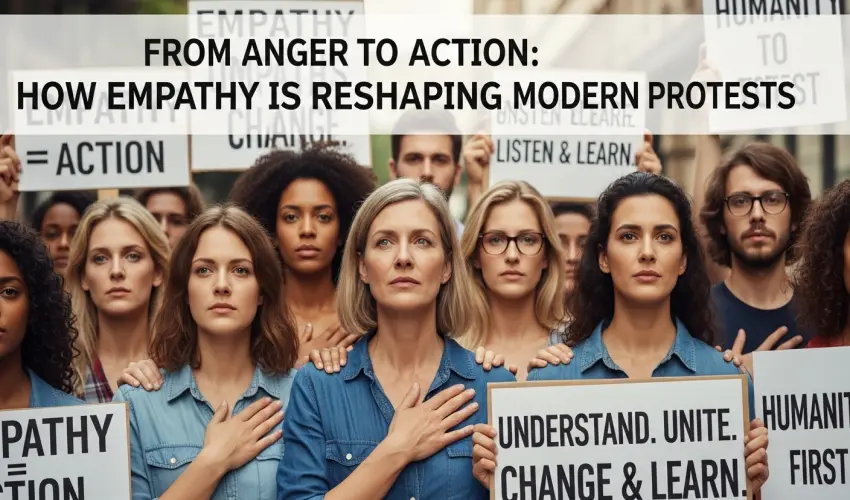From Anger to Action: How Empathy is Reshaping Modern Protests
Explore the shift in modern activism where empathy transforms anger into sustainable action. Discover how storytelling and compassion are reshaping protests to create lasting social change and policy reform.
Key Takeaways
-
Empathy is transforming protests from reactive movements into proactive forces for change.
-
Emotional connection helps translate outrage into meaningful dialogue and reform.
-
Storytelling and the humanization of issues drive participation and public support.
-
Empathy strengthens inclusivity, attracting diverse voices into activism.
-
Compassionate organizing reduces violence and fosters sustainable progress.
-
Protest leaders using empathy build trust and long-term commitment within their communities.
-
Empathy can bridge ideological divides, inviting broader coalitions.
-
Modern movements now prioritize listening, healing, and mutual respect.
-
Digital platforms amplify empathetic storytelling, making global solidarity possible.
Introduction: The New Heartbeat of Activism
Protests have long been associated with rage—furious chants, defiant signs, and fiery speeches. But a powerful shift is underway. While anger still fuels the fire, empathy is now shaping the direction of the flame. Today’s movements are evolving into something deeper, more sustainable, and ultimately more transformative.
This article explores how empathy is not replacing anger but refining it, turning protest into connection, fury into reform, and crowds into compassionate communities striving for lasting change.
The Emotional Arc of Activism: From Outrage to Outreach
Anger is a natural and necessary response to injustice. It wakes people up and moves them to action. But anger alone, if left unchanneled, can burn out or burn bridges. Empathy gives that anger direction and depth. It asks:
“What if this were me? My child? My future?”
When people protest with empathy, they do more than demand change; they invite others to understand the pain that prompted the demand. This emotional arc is transforming protests from temporary flare-ups into movements that endure.
Reclaiming Humanity in Protest Spaces
At the core of empathetic activism is a refusal to dehumanize, even those who disagree. In a time when outrage often devolves into online shaming or polarizing rhetoric, empathy is a revolutionary act. It humanizes everyone involved: the victims, the bystanders, and even the opponents.
For example, during Black Lives Matter protests, signs and speeches often told stories of lost loved ones, systemic trauma, and generational pain. These were not just chants of resistance; they were expressions of collective grief and hope that revealed the humanity behind the movement.
From Slogans to Stories: The Power of Personal Narratives
Modern protests are no longer just about slogans; they’re about stories. Individuals are sharing personal accounts of discrimination, poverty, displacement, and violence. These narratives pierce through indifference and ignite a deeper response than stats or headlines ever could. Empathy makes complex issues relatable—it’s far easier to dismiss a statistic than it is to ignore the story of a mother who lost her son or a refugee fleeing war.
How Compassion Reduces Violence and Increases Impact
Empathy has a disarming quality. While protests historically carry risks of confrontation, those led with compassion often result in more peaceful and impactful engagement. Protesters who engage respectfully with authorities, businesses, or the media—even while maintaining firm stances—are often able to influence change more quickly.
Examples of empathetic protest tactics include:
-
Community healing marches
-
Silent sit-ins
-
Art-based protests where creativity replaces conflict
Building More Inclusive and Diverse Movements
Empathy makes space for everyone. It’s not about who shouts the loudest; it’s about who listens the most. This has opened the doors of activism to people with disabilities, mental health struggles, and other barriers to traditional protest. Modern movements are becoming more inclusive, offering roles for behind-the-scenes organizers, digital storytellers, and emotional support volunteers. When empathy leads, movements become more diverse, and diversity makes them stronger.
Digital Empathy: Connecting Humanity Through Technology
Social media, often criticized for fueling division, is also a powerful tool for digital empathy. Hashtag movements like #MeToo, #JusticeForMahsa, and #FreePalestine have used online platforms to share deeply personal stories that evoke global solidarity. Short videos, heartfelt captions, and virtual vigils create a shared emotional experience across borders, allowing a protest in a small town to inspire action on the other side of the world.
Turning Protest into Policy
Ultimately, the goal of any protest is change. Empathy is key to turning demonstrations into dialogue and, eventually, into policy. Legislators and institutions are more likely to respond when movements articulate their demands through compassionate stories and clear intentions. Empathetic communication reframes the conversation from conflict to cooperation without compromising the urgency of the cause.
The Emotional Resilience of Empathetic Activists
Activism is emotionally taxing, and burnout is common. Empathy offers a lifeline by fostering community care, where protesters look out for one another and prioritize rest. Self-empathy also allows activists to navigate feelings of guilt, anger, or helplessness in healthier ways, reminding them that the fight for change is a marathon, not a sprint.
Conclusion: The Heartbeat of a New Era
Modern protests are no longer defined solely by raised fists; they are guided by open hearts. Anger may ignite the flame, but empathy keeps it burning with purpose. It transforms opposition into conversation, fury into focus, and despair into determination.
In this new era of activism, empathy is not a weakness; it’s a strategy.
It is how we build bridges instead of walls, amplify voices instead of silencing them, and create change that doesn’t just address problems but also heals wounds.
Join the conversation
Share how this story resonates with your journey. We feature standout reflections in our newsletter.

